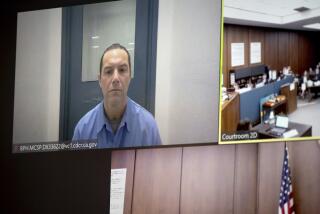Survival of Evidence Turns on Pure Luck
The preservation of DNA evidence--often the critical component in determining innocence or guilt--varies widely across the nation, depending on state laws, local policies and sometimes even luck.
“It’s a crazy quilt,” says lawyer Barry Scheck, co-founder of the Innocence Project. “It doesn’t matter what the statutes say. Everything turns on the procedures in place for storing the evidence.”
In some places, he says, biological evidence may be stored in the courthouse; in others, with the prosecutor, the crime lab or the court reporter.
Scheck says his group must close more than 70% of the cases it accepts because evidence has been lost or destroyed.
But persistence often pays off. In many cases that have led to exonerations, he says, evidence is initially reported lost, but “if we dig very hard, we can find it. It’s always a hunt.”
One common explanation for destroying evidence is overflowing warehouses.
That nearly doomed Kevin Byrd, who was released in 1997 after 12-year-old DNA evidence cleared him in a rape.
Semen evidence was almost thrown out of a crowded warehouse, but for some reason, a prosecutor drew a line through Byrd’s exhibits on a list. That meant the material was saved, after which DNA testing cleared Byrd.
Soon after Byrd’s release, Harris County, Texas, officials who prosecuted him destroyed 50 rape kits, citing lack of storage space.
Keno Henderson, chief of the county’s trial bureau, offered no details about the destruction. “I’m not saying it didn’t happen,” he said, but he says such actions are always done with a judge’s order.
Randy Schaffer, Byrd’s attorney, is suspicious.
“They didn’t want to be faced with this type of situation in repeated cases,” said the Houston attorney. “The best way to make sure . . . is to destroy the evidence.”
It was Georgia prosecutors who helped save Calvin Johnson from life in prison for a rape conviction. As it was, he served 16 years before a DNA test exonerated him.
Johnson requested DNA tests in 1994, hoping for a new trial. Prosecutors still had the rape kit, including a semen sample. They had taken it from a garbage can where it had been discarded by a judge’s clerk who was cleaning out his office.
But for some inmates, time runs out.
Centurion Ministries, a group that works to free wrongly convicted people, wanted to have DNA evidence tested in the case of Louis Mickens-Thomas, who was convicted of raping and killing a 12-year-old Philadelphia girl in 1964.
When Centurion’s director, James McCloskey, asked for the evidence in 1991, he discovered the materials that had been held for 27 years were destroyed just two months earlier to make room for other cases.
“I was heartbroken,” McCloskey says.
Questions over the availability of DNA will fade with time since the tests are now routinely conducted as part of pretrial evidence-gathering.
Congress is considering legislation that would require authorities to preserve DNA evidence as long as someone is incarcerated. It would also require states to give notice before any materials are destroyed.
More to Read
Sign up for Essential California
The most important California stories and recommendations in your inbox every morning.
You may occasionally receive promotional content from the Los Angeles Times.










